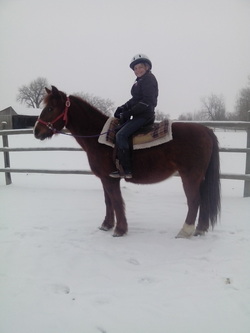
Happy Sunday!
It was so beautiful out today, and I was lucky enough to get out and enjoy it. I’m really looking forward to the pleasant weather that has been predicted for this week. My fingers are crossed that the weather forecasters are accurate this time around!
I want to spend this post discussing the importance of wearing a proper helmet while horseback riding. Contrary to popular belief, bike helmets are not appropriate to wear while riding. I’ll admit that I did not always know this, and now that I do I want to pass on the knowledge to all the horse crazy kids and parents out there.
What’s the beauty in wearing a bike helmet to ride? It is lightweight, brightly colored, and cheap. However, bicycle helmets have liner material at the top of the head and down the sides only, with comfort foam around the sweat band of the head, which offers little to no protection. Certified riding helmets are required to provide protection for specific areas and cover almost the entire back of the head.
Bicycle helmets and certified riding helmets are also tested on different surfaces. Bicycle helmets are “tested on flat, hemispherical, or curbstone anvils. The equestrian hazard anvil has a deep and sharp design, meant to approximate the angle of a horseshoe or a jump standard edge” (American Medical Equestrian Association).
Falls off a horse aren’t the only hazard helmets protect against. They can also protect you from kicks and even swinging heads. I once worked with a trainer whose helmet was cracked when a horse swung its head toward him and smashed its strong cheekbone across the top of his helmet. He was sure glad he was wearing it that day.
Many experienced riders I see choose not to wear helmets, and while this is their personal preference, I would never mount a horse without proper head protection. Being an experienced rider does not mean your head is any safer than the head of a beginner rider. I read somewhere once that while beginner riders typically fall off of horses, experienced riders are thrown off of horses. Unseating an experienced rider is not always easy, and if the rider does come out of the saddle, it will be a much more severe fall than if they were simply to lose their balance.
I don’t allow any of my students to ride without helmets, and I like to set an appropriate example by always fetching my helmet before mounting any horse in the arena. We only get one brain, and we should do all we can to protect it.
For more information on this topic, you can visit http://www.riders4helmets.com/
It was so beautiful out today, and I was lucky enough to get out and enjoy it. I’m really looking forward to the pleasant weather that has been predicted for this week. My fingers are crossed that the weather forecasters are accurate this time around!
I want to spend this post discussing the importance of wearing a proper helmet while horseback riding. Contrary to popular belief, bike helmets are not appropriate to wear while riding. I’ll admit that I did not always know this, and now that I do I want to pass on the knowledge to all the horse crazy kids and parents out there.
What’s the beauty in wearing a bike helmet to ride? It is lightweight, brightly colored, and cheap. However, bicycle helmets have liner material at the top of the head and down the sides only, with comfort foam around the sweat band of the head, which offers little to no protection. Certified riding helmets are required to provide protection for specific areas and cover almost the entire back of the head.
Bicycle helmets and certified riding helmets are also tested on different surfaces. Bicycle helmets are “tested on flat, hemispherical, or curbstone anvils. The equestrian hazard anvil has a deep and sharp design, meant to approximate the angle of a horseshoe or a jump standard edge” (American Medical Equestrian Association).
Falls off a horse aren’t the only hazard helmets protect against. They can also protect you from kicks and even swinging heads. I once worked with a trainer whose helmet was cracked when a horse swung its head toward him and smashed its strong cheekbone across the top of his helmet. He was sure glad he was wearing it that day.
Many experienced riders I see choose not to wear helmets, and while this is their personal preference, I would never mount a horse without proper head protection. Being an experienced rider does not mean your head is any safer than the head of a beginner rider. I read somewhere once that while beginner riders typically fall off of horses, experienced riders are thrown off of horses. Unseating an experienced rider is not always easy, and if the rider does come out of the saddle, it will be a much more severe fall than if they were simply to lose their balance.
I don’t allow any of my students to ride without helmets, and I like to set an appropriate example by always fetching my helmet before mounting any horse in the arena. We only get one brain, and we should do all we can to protect it.
For more information on this topic, you can visit http://www.riders4helmets.com/



 RSS Feed
RSS Feed